Flipped Strategies for Students
While flipped learning may seem quite different than traditional classrooms initially, classrooms where the in-class component was based on D.I. or differentiated instruction really is not that new. In a class using a lot of D.I., interactive individual/group work to explore understanding and application of content was routine so the only new aspect is the amount of such instruction used now with flipped learning. There will also still be times when homework take-up will be employed and traditional lab work is conducted. The real dramatic change is the reliance on video which actually is just a different method of flipping compared with reliance on handouts, document postings and web links. This is typically where students need assistance making the change; that is, they need help learning how to make notes from a video lecture which is different than an instructional how to video or video documentary.

Taking effective notes is a skill by itself and one that becomes more critical the further one moves in education. Furthermore, learning while taking notes adds another demanding layer to exercise. Both of these are not skills that magically develop over night and everyone has different needs and abilities. Now add in a video aspect and it can seem quite daunting. However, the video lecture is really no different than the traditional in-class note on the board with the added bonuses of being able to stop and replay as needed. So, really the heart of the issue is learning to take good notes that lead to higher order thinking and learning. Nonetheless, there are strategies to aid in the process of learning to be a good note taker in the context of a video lecture.
One method I recommend relies on suiting your preferred style of learning. Some students don't like to listen and read at the same time. It's fine if your goal is to simply copy the notes, but copying is not exactly learning. Well, teachers know that if something is important, you should say it and write it down. So the typed content of the video is the most important material and the spoken content is likely no different than in-class notes; that is, just a verbal recant of what was being written. So if being presented with both modalities bothers you, turn off the sound and make your notes. Then I would recommend watching the video again with the sound and using that to simply augment the notes you created from the typed content. You should realize that this is a coping mechanism and not a strategy for better note taking.
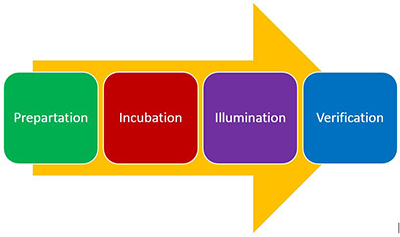
So, one method I recommend to take notes is no different than what I used to recommend for textbook or handout material. This method works when there is no accompanying sheet to the video.
- Start with the video title. Think about what it means or could mean. Write it down. This frames the content or creates a schema for learning (a mental construct for storing information).
- Skim through the video, noting slide titles and anything else that catches your attention. Again, this is creating a schema for learning.
- Now, watch the first slide. Don't write anything down, but try to really think about the content.
- Pause the video and make jot notes on this slide based on what you think your learned. Do this on scrap paper. Don't just copy the screen; in fact, don't look at the screen or minimize the video.
- Now replay that slide and work with the video and your jot notes to create the good note you wish to keep. This is an elaboration stage in which you are reinforcing what you did accumulate and expanding on what you missed.
- Check over your note on this slide to see if it makes sense. If there is something you don't understand, replay the slide or make a question to ask in class the next day. Use sticky notes or the margin for these questions so you don't forget.
- Continue through slide-by-slide in this manner.
- When you are finished the video, look over the note to identify the main concept(s) being presented. You could make note of these in a bullet list at the bottom of your note.
This method may seem slow and it definitely is slower than just copying verbatim as the video proceeds, but this method is designed to also facilitate learning which copying lacks. In a sense, you are studying right from day one which is one tactic recommended for improving authentic understanding and subsequently marks. If you have ever been in a situation where you had to learn something very quickly and present it back (at work, class inquiry work, camp programs, etc.), this is what you typically do; dive in and try to really figure out what each aspect means--there really is no other way than to analyze every aspect to ensure you understand. Over time, you should get better at this technique and time spent here should be saved when it comes to studying because you already know the material to some degree.

If the video has an accompanying sheet to aid in note-making, some accommodation of the above method is needed.
- Read over the accompanying sheet. Think about what content is about to be presented and what it could mean. This frames the content or creates a schema for learning (a mental construct for storing information).
- Skim through the video, noting slide titles and anything else that catches your attention, but as you do so, use the accompanying sheet to track the video progression. Again, this is creating a schema for learning, but now this is also helping you set the stage for how the sheet will work with the video.
- Now, watch the first slide. Don't write anything down, but try to really think about the content.
- Pause the video and look at the accompanying sheet. Decide how they integrate. Maybe the sheet has most of the valuable content and all you need to do is augment this with enhanced understanding or maybe the sheet asks a key question or presents a key statement for the slide that will become the basis of your new note. At this point augment the sheet or answer the question or elaborate on the key statement but do so in pencil on the sheet or as a jot note on a sticky note or on scrap paper. Don't just copy the screen; in fact, don't look at the screen or minimize the video.
- Now replay that slide and work with the video and your augmented/notes to finalize your work or create the good note you wish to keep. This is an elaboration stage in which you are reinforcing what you did accumulate and expanding on what you missed.
- Check over your note on this slide to see if it makes sense. If there is something you don't understand, replay the slide or make a question to ask in class the next day. Use sticky notes or the margin for these questions so you don't forget.
- Continue through slide-by-slide in this manner.
- When you are finished the video, look over the note to identify the main concept(s) being presented. You could make note of these in a bullet list at the bottom of your note.
This method may also seem slow, but remember you are attempting to learn the material; that is, to keep it in mind and not just in your binder. Over time, you should get better at this technique and time spent here should be saved when it comes to studying because you already know the material to some degree.
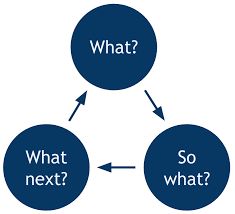
Some Other Strategies
These represent strategies that have some merit that I found on the internet. No one method has to be used exclusively or exactly as depicted. Remember, what works best for you is the best strategy for you!
An Outline Method
- Make a topic outline of the video based on the titles and subtitles and leave spaces to fill in content or use separate sheets of scrap paper--this might work better on a computer.
- As you watch the video, write some more in-depth sub-points about each topic.
- Watch each slide twice so you can elaborate on your in-depth points.
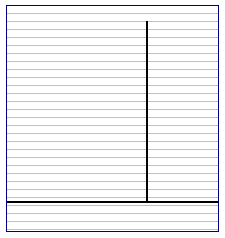
- Try to sum up the video at the end by reviewing your in-depth points.
- Use your notes to test yourself on how much you actually know rather than simply rereading them over and over.
A Structured Review Method
- Divide your note paper into two vertical sections covering 2/3 and 1/3 (or vice versa) and leave a small space at the bottom.
- Put the slide title at the top and copy out the typed content from the slide in the larger column.
- Watch the slide again, but now add learning cues and/or your own explanations in the smaller column to aid in understanding of the slide points.
- In the bottom section create a summary of the slide depicting what was the key learning outcome or value or overall point of the slide.
- Repeat for each slide in the video.
Mind Mapping
- The mind map demonstrates your current thinking about a topic and works well for science since this subject has numerous interlocking topics or complex, abstract ideas.
- Use the slide title as the center of your map.
- Now, watch the first slide. Don't write anything down, but try to really think about the content.
- Pause the video and create nodes connected to the slide title and perhaps to each other. Do this on a new sheet of paper. Don't just copy the screen; in fact, don't look at the screen or minimize the video.
- Now replay that slide and work with the video and map to elaborate on nodes with connecting words and/or new or missed connections.
- Check over your map on this slide to see if it makes sense. If there is something you don't understand, replay the slide or make a question to ask in class the next day. Use sticky notes or the margin for these questions so you don't forget.
- Continue through slide-by-slide in this manner.
- When you study, elaborate further on each map. Note that there is no correct map and in fact, the structure does not matter as the learning comes from the mapping experience itself--this is where you are exploring and restructuring your own personal understanding.

Flow Notes
- This note-taking method is not for everyone as it involves a lot of divergent personal thinking as you simply progress through the slides.
- Start with the first slide and progress from topic to topic at your own pace. Use the slide titles to organize your notes.
- As you copy content from the slides also jot down topics, draw arrows, make little doodles and diagrams and graphs that come to mind.
- The goal is to engage with the material while freely exploring your thinking.
- For some people, this allows them to draw their own conclusions better, but for some it is very cluttered, unstructured and too divergent.
Bullet Journaling
- Start with the first slide and record the bullets from the slide, but in a free-form fashion adding other valuable content as doodles, scripts, symbols and etc. This can be a slower method and some people get side tracked with the artistic aspects so remember the goal is to learn chemistry. The goal of bullet journaling is to keep your journal organized and attractive.
- The goal is to turn a blank page into a beautiful representation of your thought process. This will likely take more than one initial viewing of the video.
- When you study, add to your journal and add flare to make things stand out and personal.
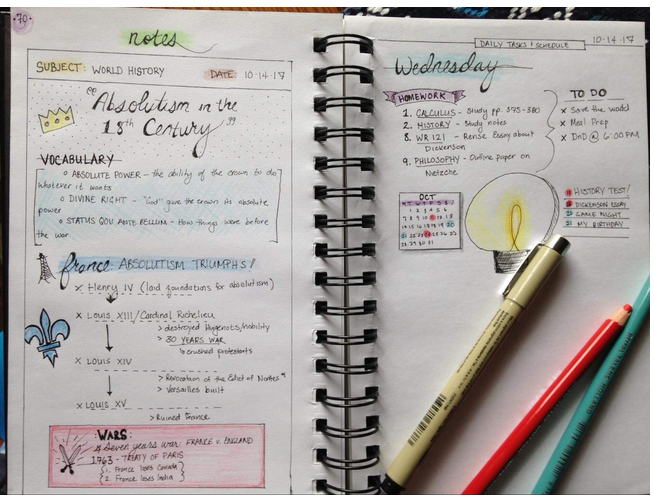
Some Failing Strategies
Time is always a constraint and adds considerable pressure for all of us to cut corners. Cutting corners on learning cuts learning, a simple truth which is as old as school itself. However, it is also the first survival technique that students attempt which is ironic since it ensures less learning and is thus, not a survival tactic. I address it here because I have seen these tactics throughout my entire career and they never pay off, but they also won't go away and in fact with technology, they are even easier to pursue. Here are some common failing tactics:
Just download the video and watch it later = absolutely no learning which means during the next class when we engage in the learning activity to correct misconceptions and expand on learning to attain a deeper more robust understanding of the concepts, you have nothing to offer and gain very little compared to your peers (essentially, you are where they were before they completed the video homework).
Just watch the video or read the accompanying sheet = any learning that takes place remains superficial developing merely by chance association which means that again that you have little to offer and gain little during the subsequent learning class in which concepts are explored (in fact, this may be worse as it allows poorly conceived misconceptions to incubate and become more entrenched).
One person or several people make one note and share it with many = the only person truly learning from the experience is the person that made notes on the video which results in very fragmented and superficial learning which delays and typically seriously impedes authentic growth during the subsequent classes as misconceptions become entrenched.
Video capture technology with subsequent not augmentation which is not terrible, but not optimum either = without spending time to make sense of the typed content and reframing it, your understanding is really my understanding and ultimately in novel situations, you must rely on memorization since you don't really own the learning.
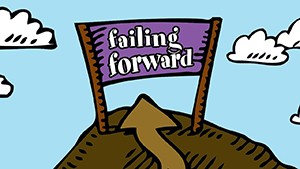
The Bottom Line
A positive attitude means everything. Anything worth attaining always takes work. These two statements have always proven to be true despite constant dedication by all of us to prove them wrong. If you constantly see things negatively, you simply reinforce that statement until it becomes a belief and then a circular proof. That is, you get what you create. So why not create a better circumstance. Be positive about the work you are doing--you are learning, you are in control and you are changing your own personal world for the better. This actually has the biggest payoff of all strategies. For example, hospital patients who believe they are improving have shorter recovery times and better overall health. Applying yourself to work at something is courageous and trust me we have all been there, but either the work is done upfront on your terms or later in repairing the damage. The choice is obviously yours, but the former strategy leads to growth and develops character which is admired by others while the later creates anxiety and ultimately requires more work than needed.
Finally, asking for assistance is not a sign of weakness, it is a strength that many lack. It is not about losing control, it is about taking control. The right help from people who care is very uplifting, affirming and an integral part of a growth mindset. |





